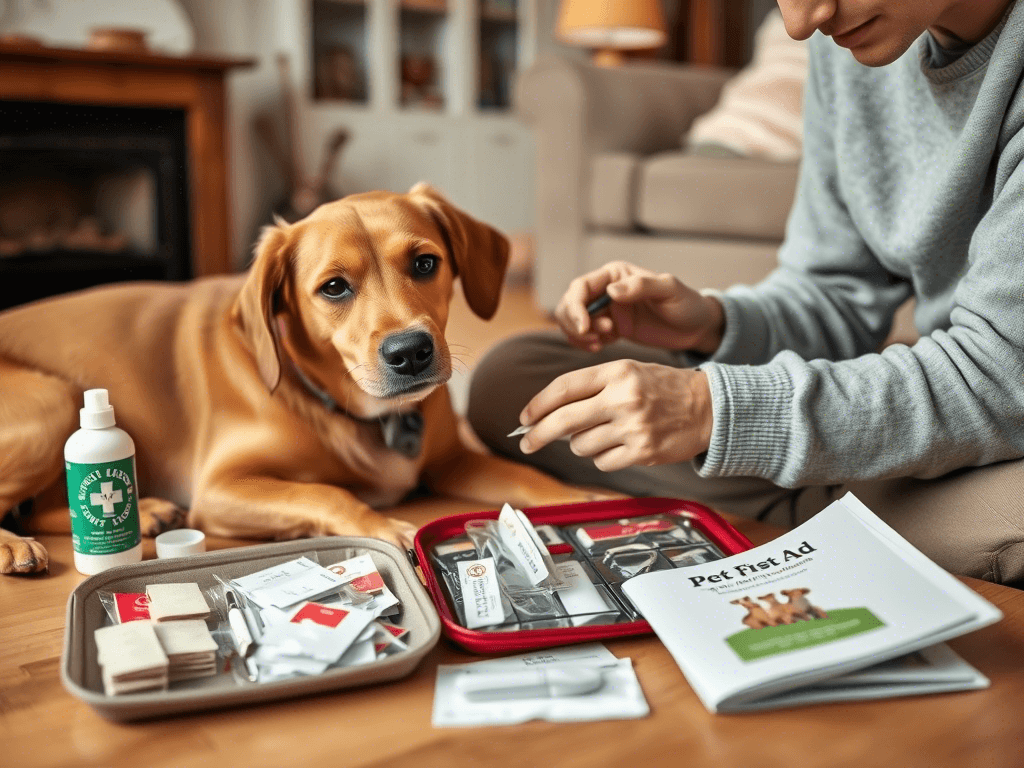As dog parents, we do everything we can to keep our pups safe and happy. But just like with human family members, accidents can happen — a scraped paw, a sudden allergic reaction, or even a swallowed object. That’s why having a dedicated first-aid kit for your dog isn’t just helpful — it’s essential.
In this post, we’ll walk you through what to include in your homemade dog first-aid kit, how to store and maintain it, and when to skip the kit and head straight to the vet.
🐶 Why Every Dog Owner Needs a Pet-Specific First-Aid Kit
Our dogs are curious by nature, and sometimes that curiosity leads to minor injuries or emergencies. A first-aid kit gives you the tools to act quickly and confidently when your pup needs immediate care — whether it’s removing a tick, cleaning a cut, or easing discomfort before you can get to the vet.
Situations where a pet first-aid kit can be a lifesaver include:
- Minor cuts or scrapes from walks or playtime
- Tick removal
- Torn nails or bleeding paws
- Allergic reactions (mild swelling, hives)
- Eye irritation
- Accidental ingestion of non-toxic substances
🧰 Essential Items to Include in Your Dog’s First-Aid Kit
Here’s a checklist of items every dog owner should keep on hand:
Basic Supplies:
- Gauze pads and non-stick bandages: For covering wounds and stopping bleeding.
- Adhesive medical tape: To secure bandages (make sure it’s safe for pets).
- Antiseptic wipes or spray (pet-safe): To clean wounds and prevent infection.
- Digital thermometer: Make sure it’s suitable for dogs. A dog’s normal temperature is about 101–102.5°F (38.3–39.2°C).
- Tweezers: For removing splinters or ticks.
- Blunt-tip scissors: Safe for trimming hair or bandages near wounds.
- Hydrogen peroxide (3%): Only to induce vomiting under vet supervision.
- Styptic powder or pencil: To stop minor bleeding, especially from nails.
- Saline solution: For flushing eyes or rinsing wounds.
- Muzzle: Even the sweetest dog may nip when in pain.
- Gloves: For your safety and hygiene while handling injuries.
- Flashlight: Helpful for checking injuries or looking into your dog’s mouth or ears.
- Emergency blanket: To prevent shock or keep your dog warm if injured.
Additional Essentials:
- Any daily medications or supplements your dog needs.
- Tick remover tool: Optional but very useful.
- Treats: To calm your dog during care.
🏠 Storage and Maintenance Tips
- Keep it accessible but secure: Store your kit in a waterproof container in a place that’s easy to grab in an emergency — like your entryway, pantry, or car.
- Label clearly: You can even mark it “DOG FIRST AID” so no one gets confused.
- Emergency contact list: Include your vet’s number, local emergency animal clinic, and pet poison control: ASPCA Poison Control: 888-426-4435.
- Medical records: A copy of your dog’s vaccine history, medications, and any allergies can come in handy during emergencies.
- Restock regularly: Set a reminder every 3–6 months to check expiration dates and refill used items.
🚨 Know When to Call the Vet
A first-aid kit is a great backup, but it’s not a replacement for professional care. Contact your vet or an emergency clinic immediately if your dog:
- Has deep wounds or excessive bleeding
- Is limping or unable to walk
- Shows signs of poisoning (vomiting, seizures, drooling, disorientation)
- Has difficulty breathing
- Has a high or low temperature
- Becomes suddenly lethargic or unresponsive
When in doubt, always call your vet — it’s better to be safe.
🐾 Final Thoughts
A well-stocked first-aid kit can make a big difference when your furry friend needs quick care. It brings peace of mind and gives you the confidence to handle minor issues while waiting for professional help.

About SniffnTail
SniffnTail is your go-to destination for everything pets. From helpful advice, tips, and insights to thoughtfully selected products and resources, we’re here to support pet owners at every stage of their journey. Whether you're caring for a playful pup, a wise old cat, or anything in between, SniffnTail offers tools and knowledge to make pet parenting easier and more joyful.
Related Articles
 Adoption & Rescue • 7 min read
Adoption & Rescue • 7 min readThe Truth About Rescue Pets: Debunking 7 Common Myths
Discover the truth about shelter animals by debunking 7 common rescue pet myths. Learn what to expect when adopting a rescue dog or cat.
 Adoption & Rescue • 6 minutes
Adoption & Rescue • 6 minutesAdopt vs. Shop: Why Choosing Rescue Saves Lives
Discover the heartwarming reasons why 'adopt don’t shop' isn't just a slogan—it’s a lifesaving choice. Learn about the real benefits of pet adoption and why rescues often make the best companions.
 Adoption & Rescue • 7 min read
Adoption & Rescue • 7 min readPit Bulls, Misunderstood: Rescuing Breeds with a Bad Rap
Discover the truth about pit bull aggression, tips for rescuing and socializing, and expert advice on adopting a pit bull for the first time.

